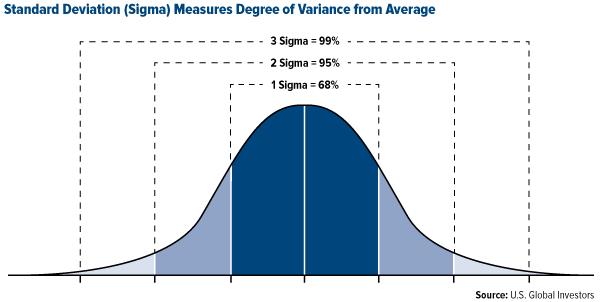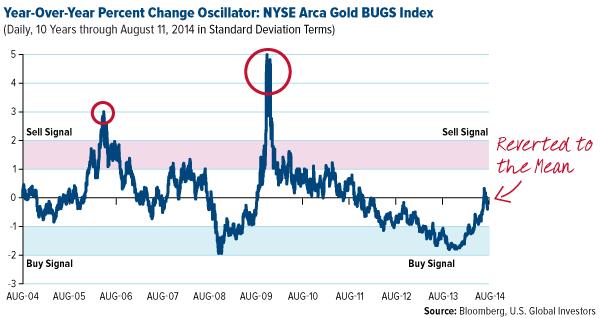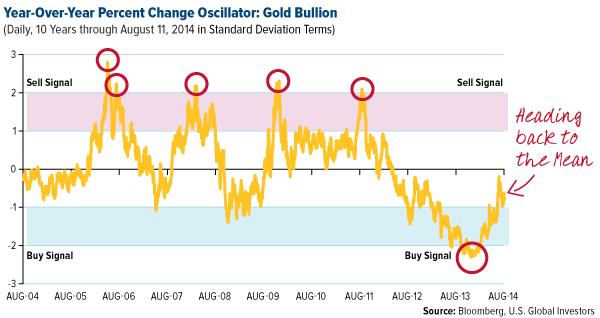Managing Expectations
By Frank Holmes, CEO and Chief Investment Officer, U.S. Global Investors
Part II of III: The Importance of Oscillators, Standard Deviation and Mean Reversion
In the first of this three-part series on managing expectations, I discussed the role cycles play in the investment management process. At U.S. Global Investors, we actively monitor both short- and long-term cycles, from the annual seasonality of gold to four-year presidential elections, in order to manage expectations based on historical patterns.
 |
Among other important cycles and patterns that we use are oscillators, which are diagnostic tools that help us measure a security’s upward and downward price volatility. Think of an oscillator as a thermometer; with it, we can accurately take a security’s “temperature.” The knowledge extrapolated from this reading is materially useful in managing expectations, appreciating the dimensionality of a security’s short-term volatility and identifying when to accumulate or trade a stock.
To understand how oscillators work, though, you’ll first need to be familiar with standard deviation and mean reversion.
Standard Deviation
Standard deviation, also known by its Greek letter sigma, is a probability tool that gauges a security’s volatility. Specifically, it measures the typical fluctuation of a security around its mean or average return over a period of time ranging from one day to 12 months or more.
In the following bell-shaped curve, the center line represents a security’s average return over a given period of time—one day, 20 days, 60 days or 12 months. To the left and right of the line, the darkest blue sections indicate one standard deviation, or sigma, either above or below the mean; the next lightest, two sigma above or below; and so on.
No matter the security, returns can be expected to trade within one sigma of their mean 68 percent of the time. Ninety-five percent of the time they will fluctuate within two sigma, and nearly all of the time they will trade within three.
So why should investors care about this? Generally speaking, the higher the sigma, the higher a security’s volatility; the probability that it will fall back toward the mean also rises. A speculative tech stock, for example, has a greater tendency to have a higher sigma than a blue chip stock. This tells you the tech stock’s returns will fluctuate more widely, more erratically, than the blue chip stock’s.
But sigma is not as black and white as this comparison might suggest. Rather, it more closely resembles multiple shades of color that help investors manage their emotional reactions to the market’s swings and focus instead on the power of using statistics. It’s easy to get pulled into market fears or “irrational exuberance”—to use former Federal Reserve Chairman Alan Greenspan’s phrase—and this probability model helps us be more objective.
To illustrate how these statistics operate in the real world, let’s look at the S&P 500 Index. Over the last ten years, it has had a rolling 12-month standard deviation of 17 percent. This means that if you were to chart its returns over the course of 12 months, you could expect them to stay within ±17 percent from the mean about 70 percent of the time. That’s one sigma. You could also reasonably expect returns to rise or fall within ±34 percent, or two sigma, 95 percent of the time.
Knowing this, it probably wouldn’t be a huge cause for celebration if the S&P 500 rose, say, 8 percent during a 12-month period, since this figure falls within the “normal” one-sigma range. Conversely, a loss of 8 percent wouldn’t be a total disaster. A one-sigma move is a non-event from a historical perspective.
To put this in perspective, the S&P 500 rose about 30 percent last year. This is close to a significant two-sigma move from its 12-month average. Incidentally, 2013 was the index’s best annual performance since 1997.
The most important thing to keep in mind is that, just as we all have different fingerprints, every commodity, every stock, every fund and every index has its own DNA of volatility. The S&P 500 might have a sigma of 17 percent, but over the same 12-month period, the MSCI Emerging Markets Index has a much more volatile 29 percent. Investors must strive to remain objective in the face of emotional factors that move markets and adjust their expectations of how these two indexes behave compared to one another.
Using Weather Statistics to Explain Standard Deviation
As an analogy, consider the extreme temperature fluctuations in Minneapolis-St. Paul, Minnesota. Minneapolis has an average annual temperature of 45 degrees, which sounds pleasant enough. You might think that in such a climate, all you need to get by is a warm jacket. But the picture changes dramatically when you learn that the Twin Cities’ 12-month standard deviation is ±22 degrees. Statistically, this means that for a little over two thirds of the year—68 percent of the time—you can expect the temperature to swing between 23 and 67 degrees. Suddenly that jacket is looking pretty risky. At two standard deviations, there’s a strong probability that the temperature will fall anywhere between a bone-chilling 1 degree—which might very well occur, since the average low in January is 2.8 degrees—and 89 degrees. That’s a huge, yawning gap that Minneapolitans must contend with throughout the year.
Compare this to San Antonio, Texas, home of U.S. Global Investors. Here the average temperature is a balmy 70 degrees, with a less-volatile standard deviation of 13 degrees. Even at two sigma—which, again, occurs 95 percent of the time—the temperature in the Alamo City statistically falls anywhere between 42 and 94 degrees, close to the average high in July.
If we’re looking just at temperature fluctuations, Minneapolis resembles the Emerging Markets Index whereas San Antonio behaves more like the S&P 500. Your expectations of “normal,” therefore, will need to be different depending on which of these two cities you reside in or indexes you follow.

Mean Reversion
This leads us to mean reversion, which I discussed in full back in June. Mean reversion is the theory that, although prices might trend up for many years (as in a bull market), or fall for many years (as in a bear market), they tend to move back toward their historic averages eventually. Such elasticity is the basis for knowing when a security is under- or overvalued and when to buy low and sell high. We have just experienced a bull market with the S&P 500 and a bear market with gold stocks. Within these trends, though, are great internal volatility and oscillator tools that monitor these actions. Even in a bull or bear market, we can measure the 20- and 60-day volatility of any kind of security.
Again let’s use Minneapolis as an illustration. We’ve already established its wide-ranging temperature fluctuations throughout the year, from highs reaching the 80s to lows flirting with zero. This being so, it would be unreasonable to expect the weather to remain freezing indefinitely, as is the case in Game of Throne’s aptly-named Land of Always Winter. Eventually it reverts back to its 12-month mean of 45 degrees.
The same goes in the world of investing. Mean reversion applies to everything, in both a micro and macro setting. In an April 2012 Frank Talk, I showed that entire countries have their own means, which they eventually revert back to. After charting Chinese stock performance over a 10-year timespan, a pattern emerged:
“Chinese stocks landed in the top half [of emerging markets] four out of 10 years—2002, 2003, 2006 and 2007. In 2003, China climbed an astounding 163 percent; in 2007, it was the top emerging market again, returning nearly 60 percent. Since then, the country has fallen to the bottom half... If you apply the principle of mean reversion, history appears to favor China landing in the top half during this Year of the Dragon.”
Indeed, by the end of 2012, Chinese stocks jumped nearly 40 percent from the previous year, placing the country in the top half of emerging markets—just as predicted using the theory of mean reversion.
Look at the two oscillator charts below. They show the up-and-down movements in the price of gold stocks (top chart) and bullion (bottom chart) over the past ten years. One row above or below the mean, indicated by the black horizontal line, equates to one sigma; two rows above or below equates to two sigma; and so on. As you can see, mining stocks have recently reverted to their mean for the first time in about three years, while spot gold is gradually working its way back.
Again, every security has a different sigma for a specific period of time, and as such your expectations should reflect these differences. Gold bullion currently has a one-day standard deviation of ±1 percent and a 12-month standard deviation of ±18.8 percent. (The one-day will always be lower than the 12-month.) So if gold’s return falls within a range of ±1 on any given day or ±18.8 percent for a 12-month period, it’s behaving normally, as this is only one sigma. Anything over 18.8 percent for a 12-month period would be heading toward two sigma, which is when a buy or sell action is advised
Now compare spot gold to the NYSE Arca Gold BUGS Index, which has a 12-month standard deviation of 35.5 percent—nearly double that of bullion. Plus or minus 35.5 percent might sound incredibly scary and volatile, but for gold stocks, a fluctuation of this sort is “normal,” occurring 68 percent of the time. It’s all about managing your expectations and emotions. Look at the following oscillator that charts the S&P 500 and gold bullion’s 60-day percent change over the past five years. Like the EKG tracings of a healthy patient, the lines bottom and peak, bottom and peak—but revert back to their mean with regular frequency.
Oscillators are vital to identifying the optimal time to buy or sell. When prices exceed two sigma above the mean, it might be a good time to sell because the statistical data suggest the commodity is overvalued and, therefore, prices are due to drop toward their mean. When prices exceed two sigma below the mean, it indicates the commodity is undervalued. Buying the laggards at this time could enable you to participate in a potential rally.
No statistical tools are accurate 100 percent of the time, but investors can take ownership in how they use probability tools such as oscillators to manage the emotions of the market. It’s when an asset moves more than one sigma that the power of mean reversion raises your chances to capture opportunity. This is part of what makes investing so exciting.
Strap yourself in and enjoy the ride.
Part III (Coming Soon)
In the third and final part of this series on managing expectations, I’ll discuss the anatomy of a bear market such as what gold mining stocks have experienced for three years. I’ll also discuss how we use relative fundamental stock evaluations, growth at a reasonable price (GARP) to pick stocks and some of the statistical tools we use to trade around core positions.
The job of active managers and the need to trade around core holdings is extremely important, especially when the daily, monthly and annual volatility is so excitable.
Copyright © U.S. Global Investors










 click to enlarge
click to enlarge





